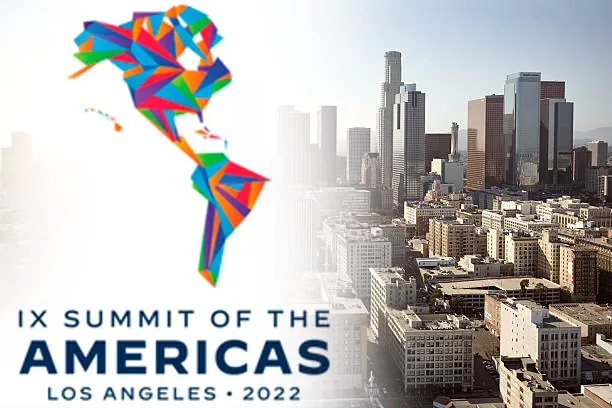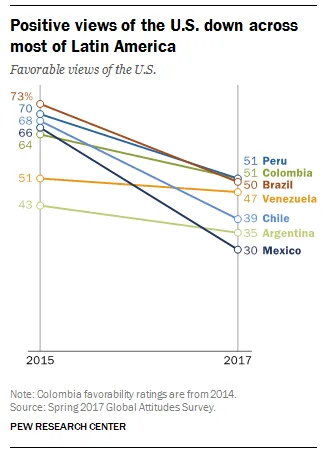
Now that the Russia–Ukraine war has entered a somewhat predictable course and any outcome seems long term, the US has scrambled to return its focus to other priority areas—the North and South Americas being one of them.
The US will host the ninth summit of the Americas from 6–10 June 2022 with a focus on building a sustainable, resilient, and equitable future in the region. Since its inception in 1994, the Summit is considered an important forum for addressing various challenges and opportunities faced by the countries in the Americas. The ninth summit is being hosted by the US for the first time after the first inaugural meeting in Miami in 1994. The US has
outlined areas where considerable action needs to be taken such as pandemic response, climate change, resolving the causes of migration, and building strong democracies. Compared to President Donald Trump, who remained absent from the last summit held in Lima, Peru in 2018, the Biden administration has the opportunity to rebuild leadership in the hemisphere. However, Biden’s vision to rebuild confidence in the hemisphere has remained unclear owing to lingering issues, especially between Latin and Central American countries, and the US. While the Biden administration has a mix of problems, which he has inherited from his predecessors, his administration’s concerns vis-à-vis Latin American and Central American countries have added to them. Some of these issues threaten to act as impediments to a successful outcome of the deliberations at the Summit of the Americas. In particular, Biden’s decision to exclude Cuba, Venezuela, and Nicaragua from the Summit has drawn sharp opposition from other Latin and Central American countries.
The popularity of the US leadership in Latin America had drastically declined at the start of Trump’s presidency.
 Source: https://www.pewresearch.org/global/2018/04/12/fewer-people-in-latin-america-see-the-u-s-favorably-under-trump/
Source: https://www.pewresearch.org/global/2018/04/12/fewer-people-in-latin-america-see-the-u-s-favorably-under-trump/
President Trump had followed a policy of ‘
maximum pressure’ against Cuba and Venezuela. A
Gallup poll showed a historic low of only 16 percent approval of Trump’s leadership. Although, under Biden, the presidential popularity ratings have improved but many of the sanctions from his predecessors continue. However, Biden has shown some intent on easing sanctions concerning Venezuela and Cuba. The Biden administration has moved to
roll back some of the sanctions on Cuba, including easing travel and remittance flows to Cuba. After Cuba, the Biden administration also
eased some energy restrictions on Venezuela too. Essentially, there are two reasons why the Biden administration has moved to ease sanctions on Cuba and Venezuela. First, the pushback from some countries on the US’ exclusion of a few countries from the Summit of the Americas has compelled the US to walk back on some sanctions. Second, the ongoing Ukraine–Russia war has forced the Biden administration to
approach Venezuela for energy needs, especially on the back of little impact of such US requests with its Middle East partners such as Saudi Arabia and the UAE. These efforts are in the direction of salvaging the upcoming summit, as many Central and Latin American countries have
threatened to boycott the summit.
The ongoing Ukraine–Russia war has forced the Biden administration to approach Venezuela for energy needs, especially on the back of little impact of such US requests with its Middle East partners such as Saudi Arabia and the UAE.
Whilst it could make or break the Summit of the Americas, this newfound unity amongst the countries of Central and Latin America could compel the Biden administration to change its policy course towards the countries of the region. At the upcoming Summit, countries of the region could unite to ask for further revisions in continuing sanctions from the Trump era. For instance, there has been no relief from sanctions in countries like Venezuela and Nicaragua in a bid toward the restoration of democracy. Instead,
sanctions have strengthened under the Biden administration, despite the growing evidence of their low effectiveness and negative impact on the standards of living caused by accumulated sanctions. The policy towards Cuba has not changed much either despite announcing the policy to return to
détente towards Cuba after the elections. The hostility of the Trump era still continues in the current administration giving the US very little chance to have considerable leverage in the island nation. The Summit of the Americas provides Biden the chance to recalibrate US’ relations with some countries in Central, Latin, and North America and restore some of the lost hemispheric influence in the region.
The spotlight of the summit is on the host—the US—as there have been speculations on how much success the summit will eventually lead to. The Summit’s success will depend on the attendance of the number of heads of the state, but sadly several countries in Latin America have
reservations about attending the summit, including Mexico, Bolivia, Honduras, and Brazil. Even Caribbean countries have threatened to boycott the summit.
For the US, a primary concern with these countries is the continuing democracy deficit, and in some cases complete lack of respect for democracy. There has been a tendency in the political governance of some of the countries in the region to undermine democracy and sway towards authoritarian regimes, leading to disappointment in the US. For instance, Brazil’s increasing
proximity with Russia,
allegations against President Bolsanaro of rigging elections, and pursuing
anti-climate policies leading to mass deforestation in the Amazon have made its relations with Washington strained. On the other hand, President Bolsanaro also fears facing US pressure at the summit to respect the democratic process in his country. As such, some of the uncertainty on behalf of several countries for attending this year's summit may also be partly due to the pressing challenges faced at homes such as economic recession due to pandemic, inflation, rising corruption, and weak democratic institutions.
President Biden’s Build Back Better world (B3W) for infrastructure and social welfare projects, and its promises for Latin American countries remain stalled in the Senate, as hardly any major infrastructure or investment plans impact Latin America.
In the event of the absence of big regional countries such as Brazil and Mexico from the summit, Biden’s objective to consolidate hemispheric leadership and repair relations with regional countries may be derailed. The summit’s importance is already
criticised as empty if held in the absence of Brazil and Mexico—the two largest countries in the region. However, if Biden’s recent steps to roll back sanctions and improve relations with countries of the region prove effective, his administration will be looking to achieve foreign policy objectives riding on issues such as change, defending democracy, and stemming migration.
Even as the Biden administration aims to restore leadership and credibility globally, there is a lack of concrete programmes for Latin American countries. For instance, President Biden’s Build Back Better world (B3W) for infrastructure and social welfare projects, and its
promises for Latin American countries remain
stalled in the Senate, as hardly any major infrastructure or investment plans impact Latin America. Another such programme is “
Call to Action” initiated by Vice President Kamal Harris, which aims at curtailing the main root cause of migration in Central America and has received meek cooperation from the Northern triangle governments leading the Vice President to take support from civil society, which lacks the credible political influence needed to tackle the problem of migration effectively.
The critics from the Latin American countries view the US threat to exclude some countries from the summit as discrimination against countries by excluding them based on tense diplomatic relations with the US. This may especially be true in the case of Cuba, which had been consistently banned from the summit for the first six consecutive years. An additional factor that has changed the hues of the US politics in the region has been the changing relations of some of the regional countries with China and the latter’s growing influence in the region. Many Latin American countries have welcomed Chinese investments for the development of their infrastructure, which has further eaten into the space for US leadership in the region. For the Biden administration, repairing relations with countries in the American hemisphere is juxtaposed with the realisation of the need to compete with China on infrastructure projects. The growing influence of China in Latin America underscores the immediacy that undergirds developing capacities in the region for the US. The Summit of the Americas may well provide the Biden administration an opportunity to streamline and convey some of the benefits intended under the B3W programs for Latin and Central American nations. For Washington, the path to regaining hemispheric influence and edging China out may very well depend on how forthcoming regional countries across the geographic expansion of the Americas are.
Many Latin American countries have welcomed Chinese investments for the development of their infrastructure, which has further eaten into the space for US leadership in the region.
The last summit’s main outcome was to tackle anti-corruption practices, much of which failed. This year’s ninth summit places a special significance on the Biden administration given the Chinese expansion of influence in the region economically. The Latin American countries see no obligations to stay under the US influence and have found grounds for collective opposition and even boycott. The summit needs a pragmatic proposal for the problems faced by the Latin American and Central American countries with a serious accountability focus in its implementation. The summit provides an opportunity for the Biden administration to build a concrete plan and manage political perceptions of the US in the Americas. If successful, the summit could pave the way for building a plan to regain regional leadership by the end of Biden’s term and facilitate better intra-regional relations in the western hemisphere.
The views expressed above belong to the author(s). ORF research and analyses now available on Telegram! Click here to access our curated content — blogs, longforms and interviews.



 Now that the Russia–Ukraine war has entered a somewhat predictable course and any outcome seems long term, the US has scrambled to return its focus to other priority areas—the North and South Americas being one of them.
The US will host the ninth summit of the Americas from 6–10 June 2022 with a focus on building a sustainable, resilient, and equitable future in the region. Since its inception in 1994, the Summit is considered an important forum for addressing various challenges and opportunities faced by the countries in the Americas. The ninth summit is being hosted by the US for the first time after the first inaugural meeting in Miami in 1994. The US has
Now that the Russia–Ukraine war has entered a somewhat predictable course and any outcome seems long term, the US has scrambled to return its focus to other priority areas—the North and South Americas being one of them.
The US will host the ninth summit of the Americas from 6–10 June 2022 with a focus on building a sustainable, resilient, and equitable future in the region. Since its inception in 1994, the Summit is considered an important forum for addressing various challenges and opportunities faced by the countries in the Americas. The ninth summit is being hosted by the US for the first time after the first inaugural meeting in Miami in 1994. The US has 
 PREV
PREV



